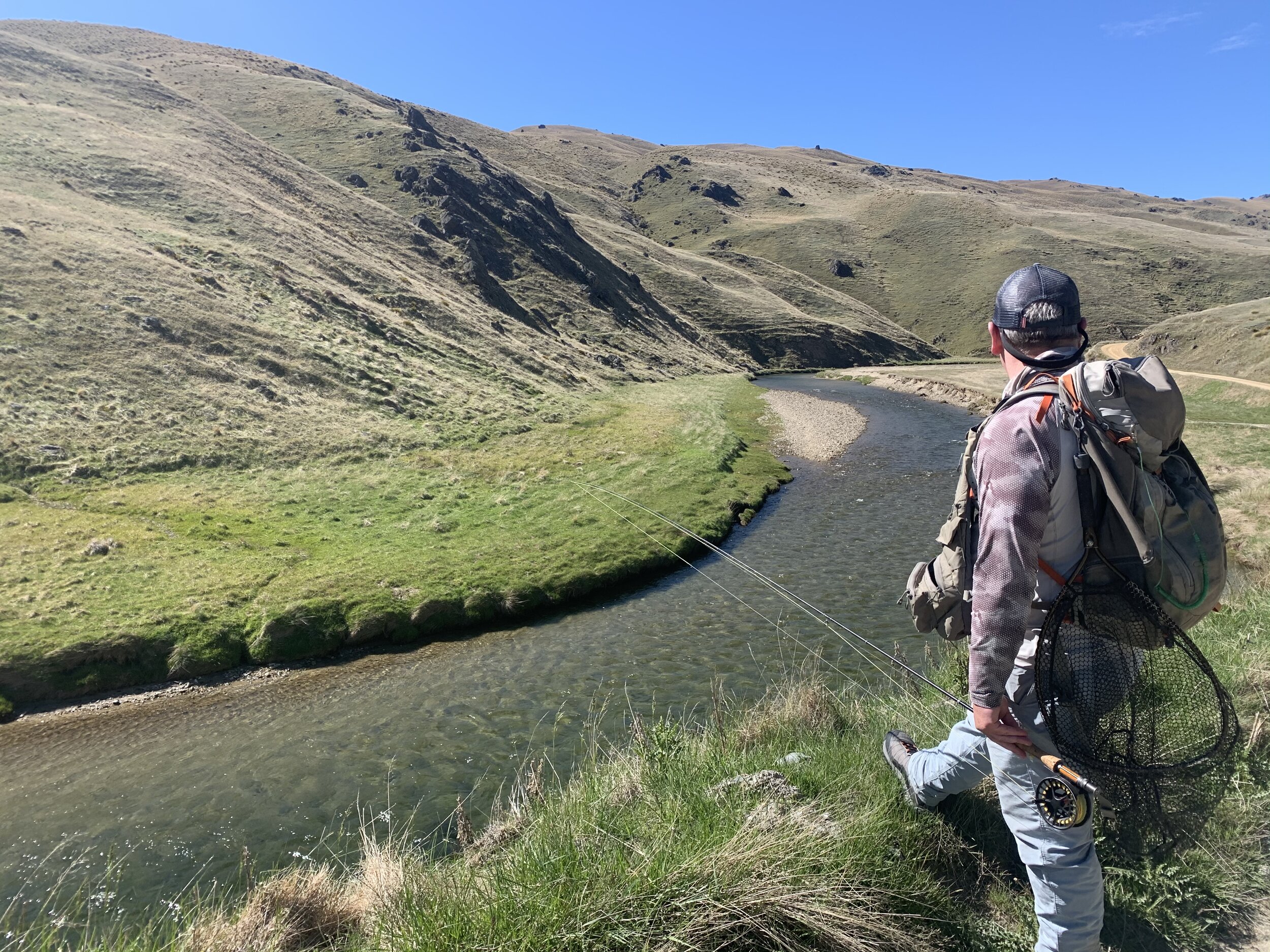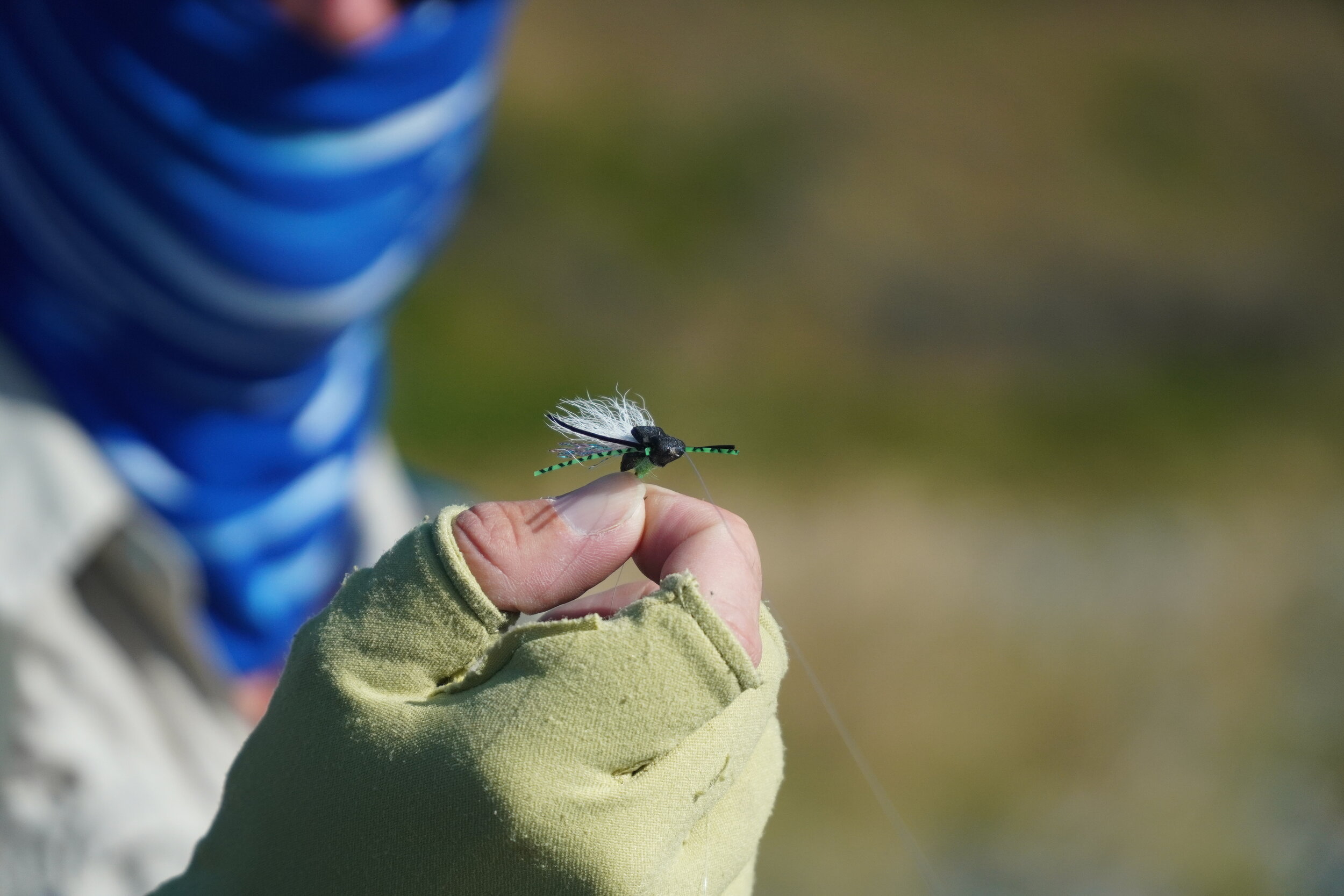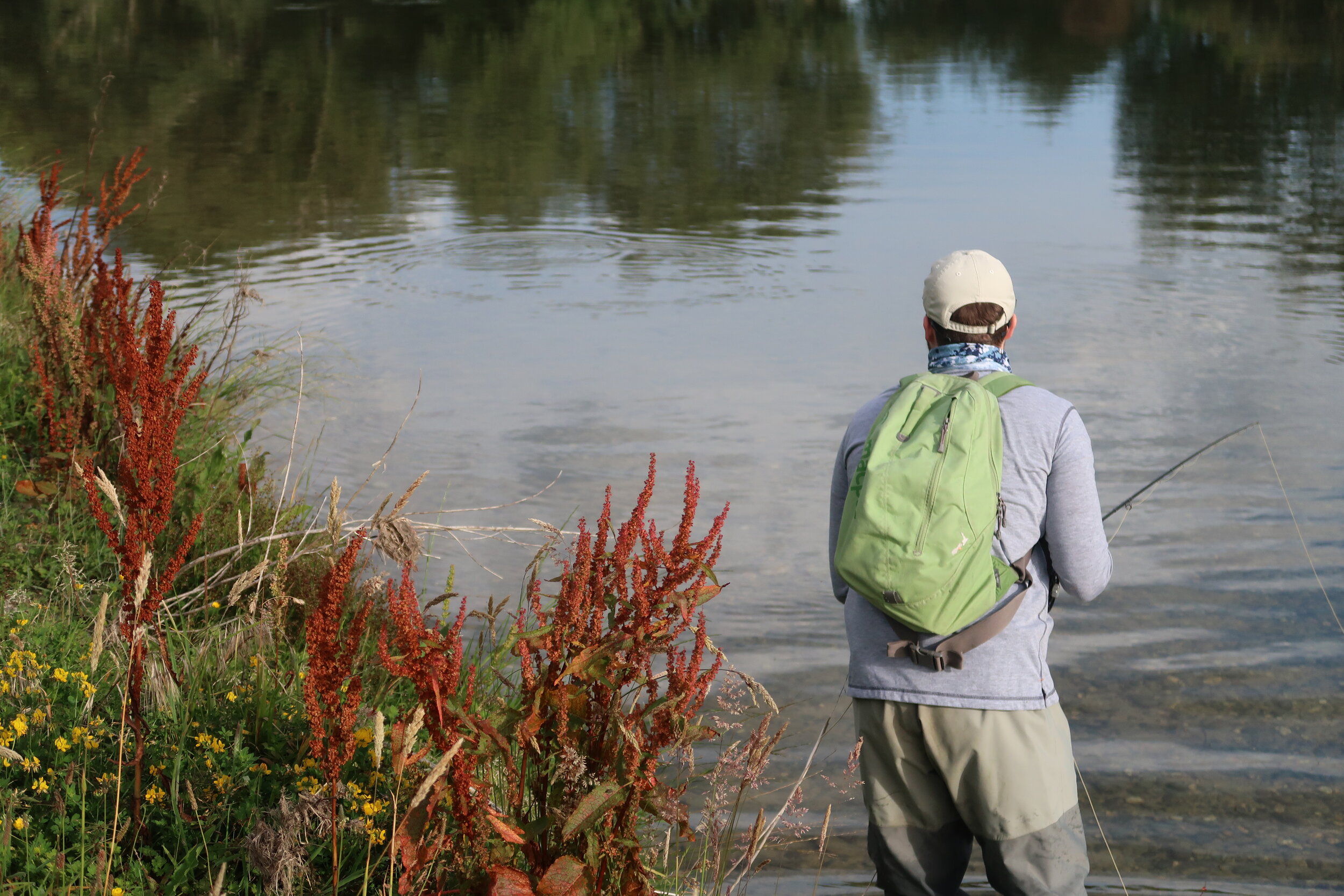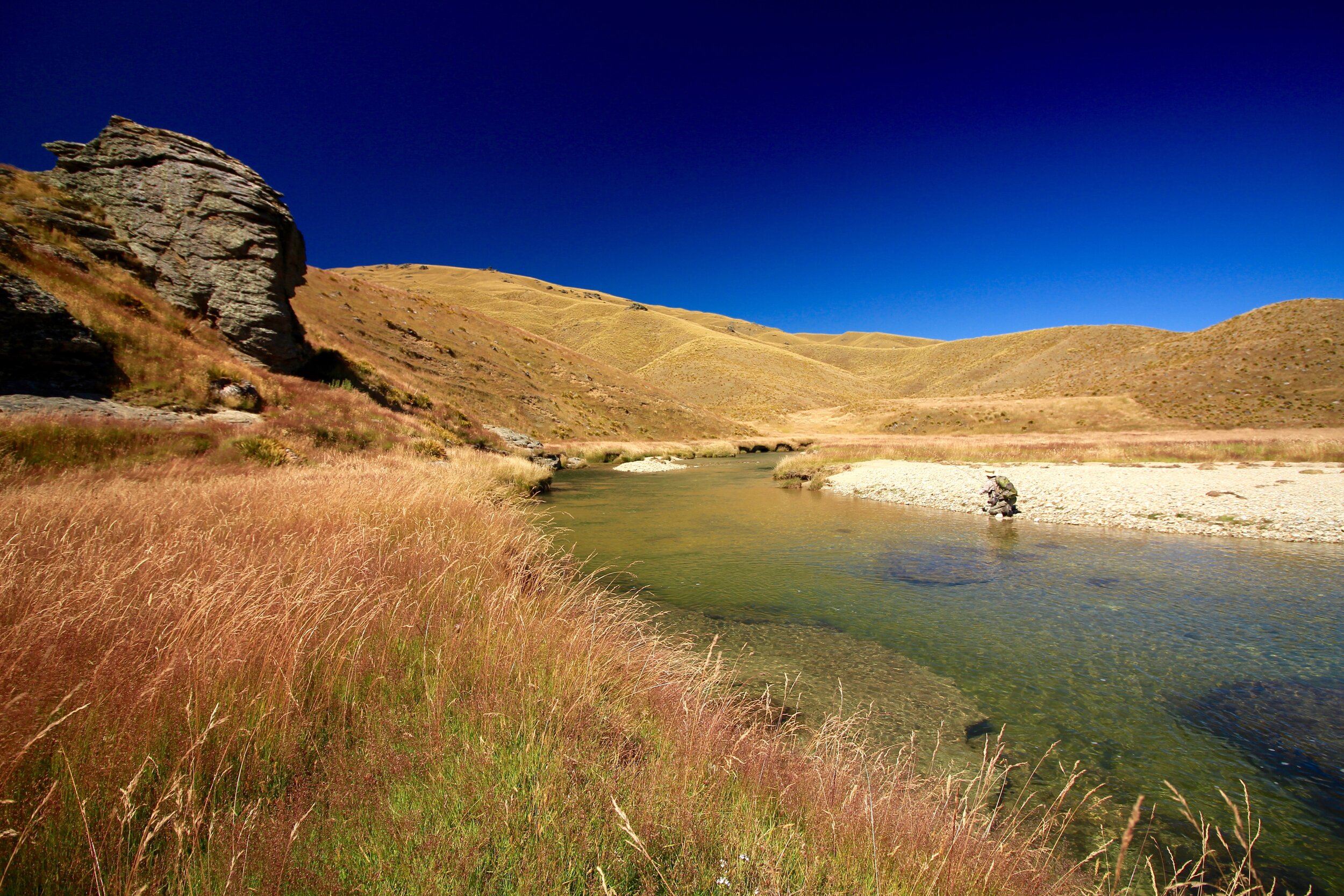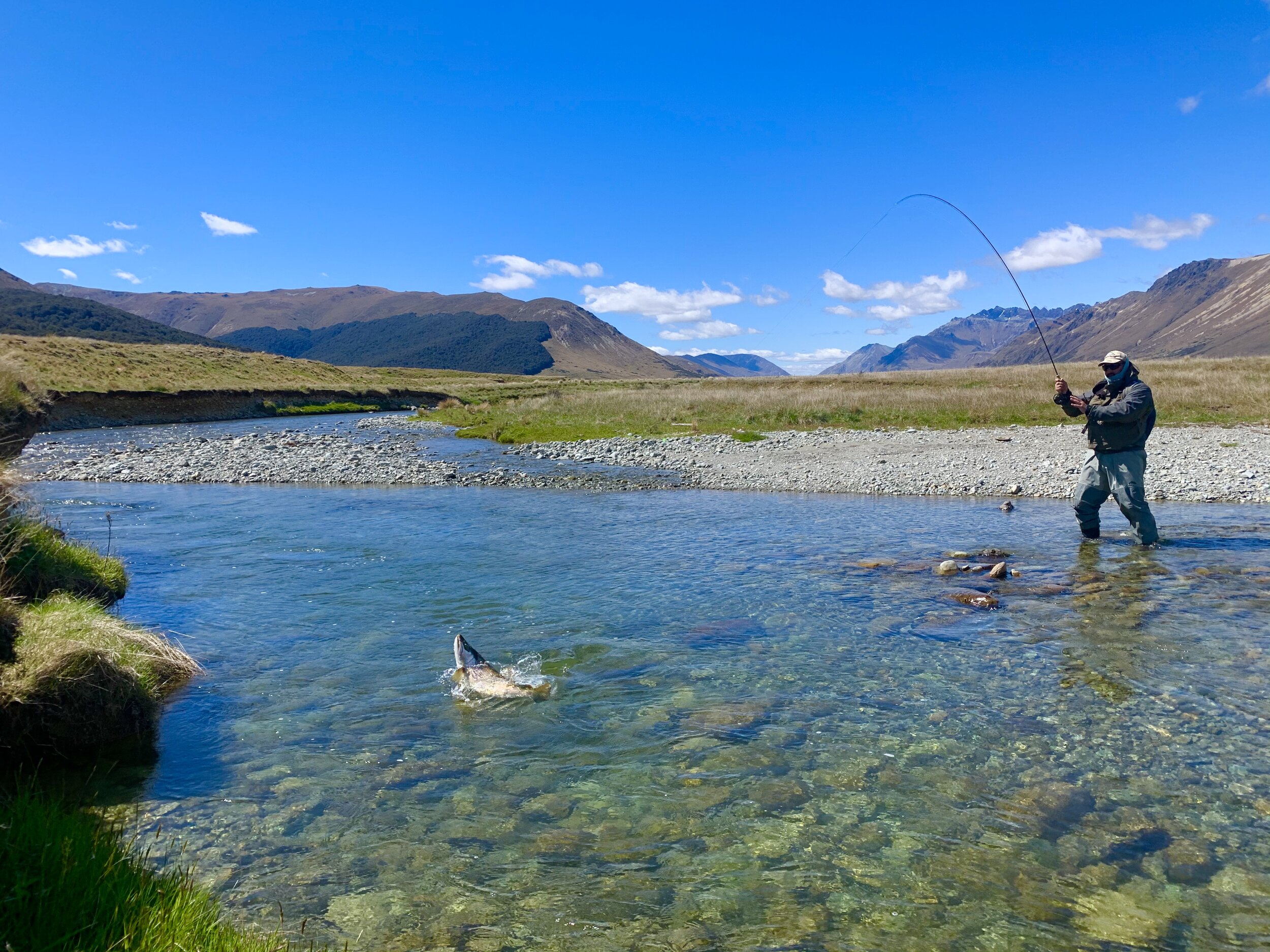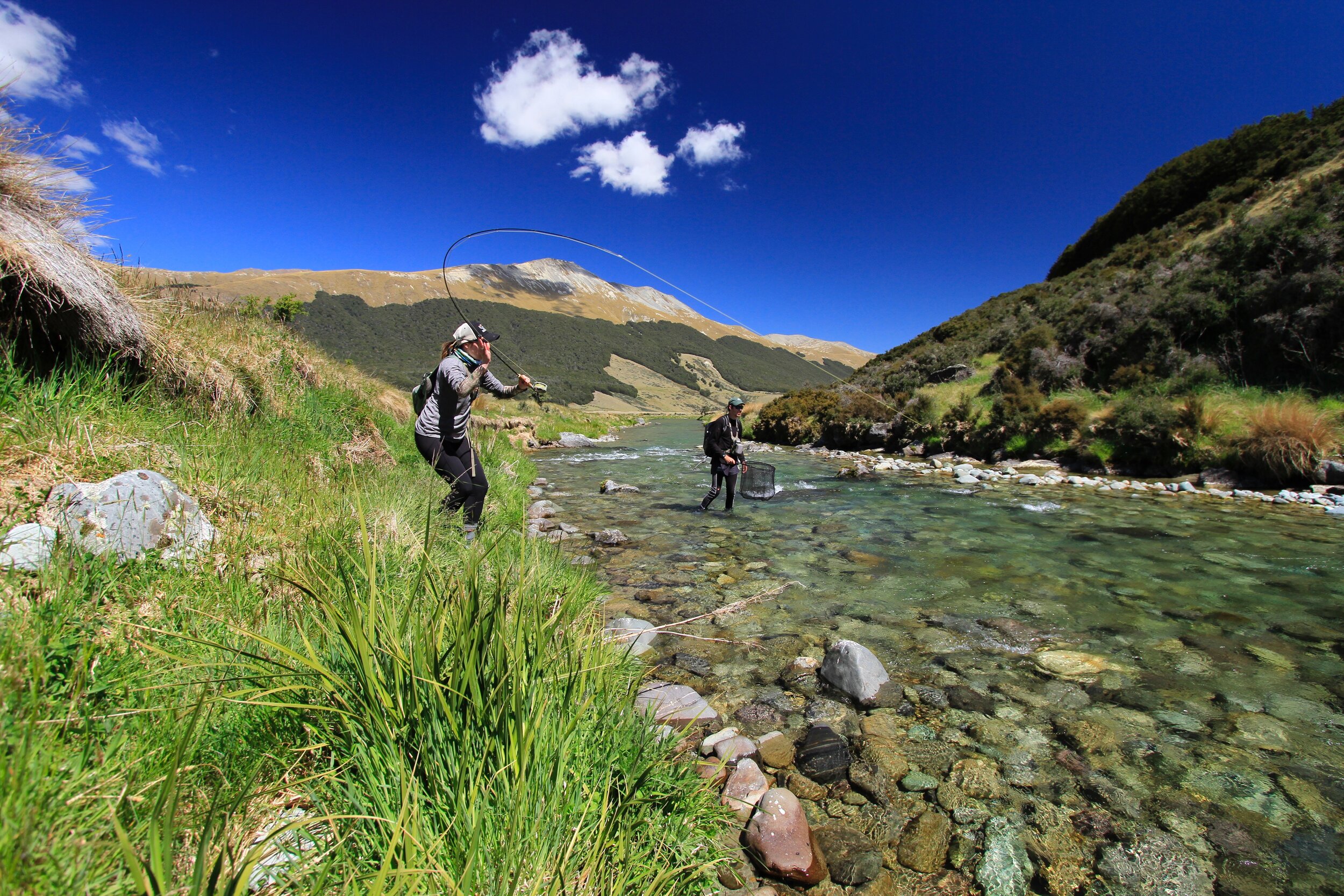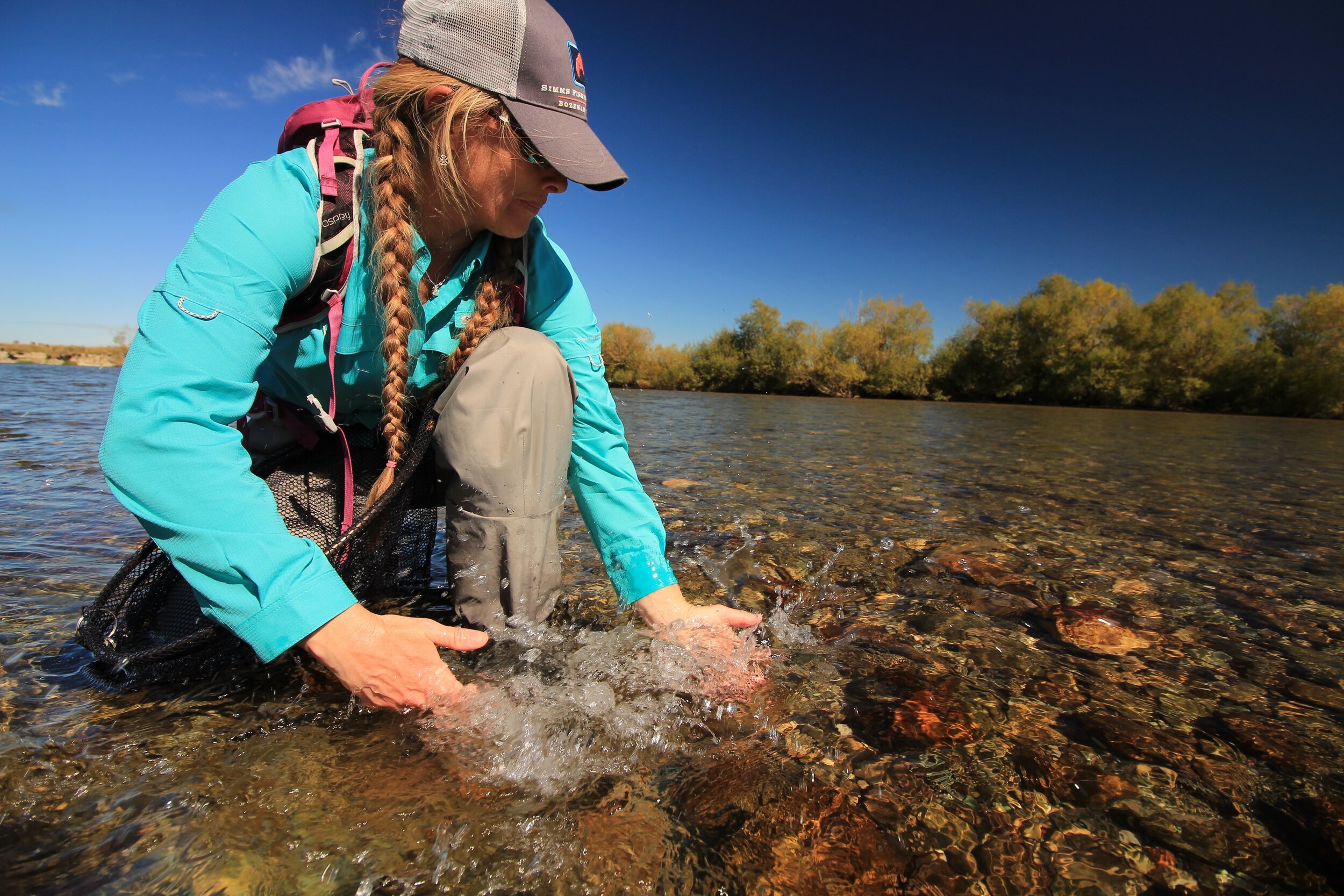
Chris Dore
Photos Chris Dore
Chris Dore Pro Fly Fishing Guide
1 Choice of equipment Rods, reels, fly lines, fly floatants, clothes, glasses and other useful items.
With the modern trends towards fast, faster and fastest I believe that for the more technical ‘match the hatch’ trout streams of the lower South Island you need a rod with more precision and control of a gently unfurling line. High line-speed is great in a number of situations, however once that line straightens a fast moving line will kick, and present heavily on the water. The smooth, medium action of my Scott G, 8’8” 4 and 5wts both protect the longer, lighter tippets we rely on here in the South and turn over our flies with exactitude, and delicacy. They load nicely on the shorter casts I see so many anglers struggle with, and the common NZ conundrum of presenting a fly to a fish with more leader than flyline outside of the rod tip.
However sometimes we need a little more oomph such as when presenting large dries into our ever constant winds, a daily challenge on many of our back country streams. Despite the blustery conditions, the water is still gin clear and so shortening up, and lightening up our leaders is not often an option. This is where the effortless line speed afforded by a fast action rod comes into play however in modern times fast doesn’t need to mean stiff. The more responsive, smoother tip of the 5 and 6wt Scott Radian, and now the Centric protects lighter tippets while retaining a fast taper with power below.
Loaded on both are presentation taper lines rather than more aggressive, ‘modern’ tapers as I feel good technique will turn over big flies, long leaders and handle the wind more precisely than a punchy line while retaining that all so important presentation. Regardless of your line, you must clean and dress it often to ensure it floats well, repels water and is free of dirt, grit and surface scum.
I look at floatants as a system rather than individual items. I utilise a good gel floatant such as Aquel, (or Lochsa for hair wing dries) to initially dress my fly, and a desiccant such as Top Ride to remove moisture once waterlogged or removed from a fish’s mouth. An amadou patch is never far from reach for rejuvenating cdc patterns or more absorbent terrestrials, and bare in mind you may not always wish to dress your flies. A waterlogged upwing, or a sunken beetle may be just what you require on spookier fish.
Just as importantly I carry a pottle of Snake River Mud to dull down my tippet on calmer, brighter days. Mud is also handy for ensuring the abdoman on damp / dry patterns and unweighted nymphs submerge.
2. Leader material, build up, length and knots.
Im a firm believer that casting ability will turn over any leader system so am happy sticking to factory tapers, with Trouthunter being a favourite. The thicker, extended butt section provides more stability when turning over wind resistant dries at distance and allows me to extend out my tippet for the rigs I often require at 13 - 20’. To a 10’ 2x leader I may add a foot or two of 3x nylon followed by my tippet to both continue the taper and to build out a longer leader, or employ a 15’ leader to a tippet ring for longer, more powerful rigs.
Recently I have become a fan of tippet rings for some situations, especially on rivers of varying character where we may require 3x and a bigger dry on one reach, then 5x to a size 16 film fly the next. A tippet ring makes it quick and easy to regularly switch out your tippet, and drop down greater in diameter from your leader to fly.
Im personally a fan of a high quality nylon over fluro as I use a lot of subtle film flies. With the sinking character of fluro, tiny cdc’s and the like get dragged under and waterlogged on the pickup when employing flurocarbon, and I favour a quality nylon for its suppleness, moving in and out of micro currents with less effect on my fly.
I believe you should choose a great leader to tippet knot, and a great tippet to fly knot and learn them well. Practise them often when not on the water for it’s easy to get rusty. I change my knots often to ensure they are as strong as can be. If you lose a fish due to a fresh knot parting, well, that’s fishing. However if you lose a fish to a knot that hasn’t been changed for several hours and a couple of fish then buddy, you may have been able to avoid that.
With modern, hi tech, fine diameter leader material its important to pay more attention to your knots. Tie them well, ensure the coils are correctly and snugly seated and they will serve you well. Rush them and there will be tears. Here’s a tip: push the coils down with your fingernail rather than simply pulling it all tight.
3. Approach and stealth.
Look, if that fish knows you’re there, you’re not going to catch it. Stay aware, keep low, move slow, wear subtle tones inkeeping with your surrounds and rely on a longer, well practised cast rather than getting too close to the fish. If you can see him, he could easily see you.
Imagine standing in a field reading a book. You’re engrossed in that book. If someone tip toes quietly and stealthily up behind you, chances are they could tap you on the shoulder before you know they’re there. However if they’re cartwheeling and wahooing you’ll see them a mile away... trout are looking for food, not looking for anglers. Move low, slow and smooth and you will be amazed how close you can get if needed without breaking their focus
4. Reading the water.
First. Find a stable section of river. We generally don’t have big numbers of fish in our rivers here in NZ so fish will be found in only the best of the water.
Look for food source: upwind grassy banks, willow trees ( willow grubs ) or a stable, rocky riffle ( mayfly ) and the concerntrated currents below. Simply look for where the food will come from and focus on where it will end up en masse ( foam lines, edge waters and eddies ). Trout don’t really have any birds of prey to be mindful of here in NZ and so will often be found well out in the open, well away from cover. Simply look for where the highest concentrations of food are to be found and that’s where you’ll find your fish.
“Spend most of your time, in the best of the water”. Write that down.
5. Casting ability which casts are essential.
Your straight line cast is the least useful cast in most river flyfishing scenarios. Accuracy however is a must. Learn to manipulate your line through aerial mends and on the water mends to get the drifts you need. Most people come to NZ totally unprepared. If you cant pick up a 20 - 40’ cast ( thats only 2 - 4 rod lengths from where you’re standing btw, but a few car lengths ) and replace it gently and accurately without 15 false casts then chances are you’re in for a tough day. Our leaders are longer than what most are used to also, 13’ to 18’ on average, often with an indicator and 2 x tungsten nymphs, or a bushy dry and tungsten dropper.
Oh, and its usually windy here too and we cant really avoid that.
Sound daunting? Its actually not, and if you spend 10 minutes, a couple of times a week on your lawn practising, these fundamental casting abilities really are a piece of cake.
6. Entomology, what should we know.
All anglers should know most importantly the size of the naturals in the stream youre fishing, and the shape / profile of said naturals, especially on our more hatch driven lowland waters where trout can feed very specifically at times on spent spinners, emergers and willow grub. The difference between a #14 and 16, or a #16 and 18 may not seem much to us, but it does to a trout. In general our NZ trout aren’t too choosy, you just need to know what’s available, match it, and present it well.
Turn over a rock in a riffle and simply match what you see crawling around in size, profile and colour or stand instream and see whats floating in the film. That’s pretty much it.
7. Rise forms Can they tell us something?
Sure can. More so on our more prolific front country waters IMO than in the backcountry, where trout end to feed much more opportunistically. The key difference is between feeding activity beneath the film, within the film or on top of the film. The ability to recognise this and employ flies that sit beneath / in / on the surface film accordingly is often the difference between a wet, or dry net on the Mataura where mayfly numbers are prolific enough to encourage specific feeding behaviour. Trout will simply ‘lock on’ to the most prolific phase of the hatch, most notably the emerger. Same too with willow grubbers to a degree when these tiny terrestrials drop in huge numbers.
8. Fly selection, size, shape, materials, which flies are essential, favourite fly.
Im a huge fan of minimalist film flies ie: sparsely tied damp / dry patterns which ride within the surface film. To this effect I replace hackles with CDC or Tiemco Aerowing and pretty much dress the remainder with a sparsley dubbed or wound body, and tail filaments or shuck as required. For example, my mayfly and caddis are simply hare fur and aerowing, and my cicada, just polydub and deer hair.
My dry fly box features heavily of mayfly, beetle, tiny ants, blowflies and a good, hi viz general terrestrial pattern / indicator dry. Emergers and para style patterns are my go to on most waters.
Nymphs again are sparse and representative of the size and tone of the naturals common to the river. I employ hotspots and trigger features in low light or if I feel they’re simply not getting noticed but the biggest factor / variation in my nymph box is weight... our gin clear water is deceptively deep and swift, and much of the time if the fish isn’t moving to your fly, that standard tungsten beadhead is just not getting down. On a dry fly blog you may wonder why I’m discussing nymphs? Well in NZ, they’re simply what most trout are feeding on, most of the time, and they’ll only look up if food is plentiful enough to make it worthwhile.
If a fish wont eat your size 14 or 16 para adams or hare or copper / pt, chances are your presentation sucks.
Favourite sub surface pattern? The Glister Nymph. Basically its just a hare and copper tied with a buggy brown dubbing, with subtle flash. Presented in or beneath the surface, It just looks like what trout want with just enough bling to catch the eye.
Favourite surface pattern? The CDC emerger. And lets face it, the trout love it too.
9. Presentation and drifts.
Theres no disadvantage to becoming the best caster you can be, so practise your presentations for every situation. Short, long, piles, curves and rolls. If all my clients got off the plane with a killer reach mend, to both the right and to the left, and the ability to roll cast then many more fishing situations could be better dealt with and many more fish brought to the net. Pretty much worldwide at a guess...
My top presentation advice? Forget long drifts. They may look good on video but are very ineffective on the water. The longer your fly is drifting, the more the currents are pushing, pulling and dragging your line, leader and fly. Land the fly as close as you can get away with to the fish to avoid these troublesome microcurrents, and present your fly drag free.
10. Upstream or downstream?
You cant really answer that unless youre on the water, there and then. If you’re on a wide open, tussocky high country stream theres no way you can get above the fish without him seeing you and yet, on hatch driven waters where trout are uber focussed, or smooth, Mataura glides where you need a fly first presentation and have the luxury of cover, a downstream drift can be essential. On some of my favourite Lower Mataura pools we often begin at the head of the pool and fish downstream to rises using an upstream reach, parachute or pile cast and feel that some days, when fish are feeding super choosy, this can be the only way to make the most of your chances.
11. fighting fish.
Use the strongest tippet you can get away with. Keep the rod low and wide to bring the powerful butt section into play, utilise the angles, and use approproate kit. You’re not ‘hardcore’ targeting 6lb plus fish on 3wts. No one wants to see that shit. Think about the trout before you fish for instagram likes.



